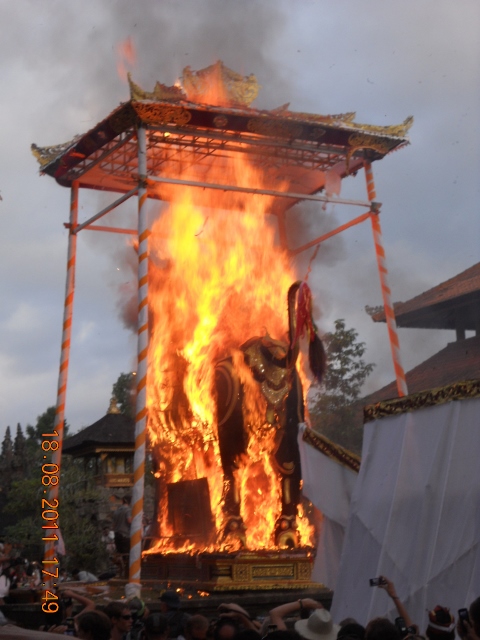
08 Mar Bali — The Cremation of a Hindu Queen
We were rambling through a temple in Ubud when we came across a platoon of Balinese making complicated constructions out of flowers. The queen had died back in the spring and her funeral was going to be the event of the decade.
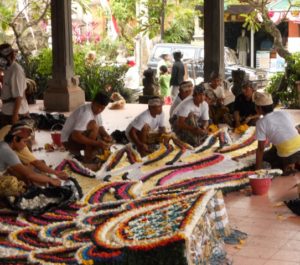
Weaving flowers together for a dead queen
It would be an all-day affair. A cab driver, who looked to be in his fifties, told us he’d be bringing his children from a not-so-nearby-village to watch. This was only the third such funeral in his lifetime and he didn’t think there’d be any more.
Indonesia is a country with six-thousand inhabited islands and a functioning central government. Why a single city on a smallish island should even have a queen, or why outlying villagers would feel like she was their queen, too, was never revealed. But whatever the reason, she was dead, her funeral was next week, and everybody in town was invited.
Peg and hadn’t planned on being in town next week, but those were plans worth changing so, come ten o’clock the morning of the appointed day we were packed into the main street along with thousands of other funeral-goers.
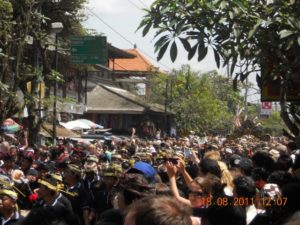
Waiting for the festivities to get started
Throngs of tourists wandered around taking pictures of things or stood in doorways taking pictures of things. Gorgeous Balinese women in white blouses and richly colored sarongs joined old people sitting on mats. Vendors were everywhere. A middle-aged lady walked past with a stack of conical straw hats on her head. Men sold balloons and plastic whirly-gigs for kids to buzz through the air. Children scampered about, and entire families puttered by in slow motion on motorcycles. Nothing about it felt funereal, not in the way Westerners feel about funerals.
Come one o’clock in the afternoon, village bands began marching by with drums and bells and bamboo xylophones. Many bands from many villages with many, many drums and bells and bamboo xylophones. Somewhere along in there, utility workers started dropping powerlines. Something big was coming down the street.
It turned out to be a twenty-five-foot-high black, sarcophagus bull with gilded horns, a double strand of golden beads around its neck, and a massive gold breastplate. As gaudy public spectacles go, that bull beat anything in Mardi Gras all hollow.
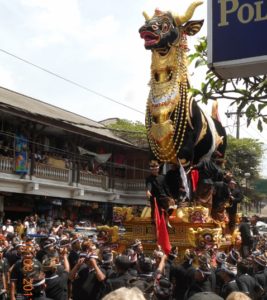
A Bull to behold
But big as it was, and sarcophagus as it was, the queen wasn’t inside.
She came later, behind more bands with more bells and more drums and more bamboo xylophones, teetering along inside a seventy-nine-foot-high, bright red, gold-leafed tower called a bade. The bade was emblazoned with figures of gods and demons and fronted with looked to me like a huge swan or, maybe, a phoenix, but that I’ve been told by people a lot more knowledgeable in these arts than I am, is probably Garuda, the king of birds that Vishnu flies around on.
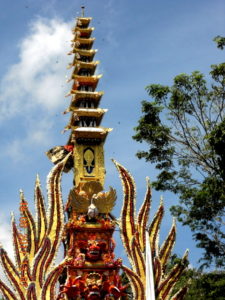
The queen is behind the part that looks like a bishop’s hat
It took a hundred men at a time to carry the bade. They’d take a step, the bade would wobble the right. They’d take the next step, the bade would wobble back to the left.
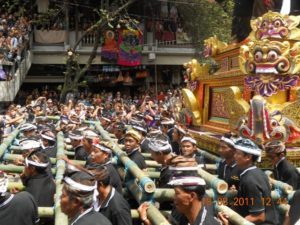
Carrying the bade was not light work
After a block or so, they would set it carefully onto the pavement where another hundred men representing a different village would take over. This happened thirteen times before the bade reached the gates to the cremation grounds: fourteen-hundred men from fourteen villages. Carrying a bade is an honor that no man and, and no village, wants to be left out.
Inside the cremation grounds were bleachers for, maybe, 200 spectators. Outside with us were 20,000, maybe 30,000, would-be bleacher sitters, all moving toward the gates. While we inched our way along, a couple of street urchins broke the queue, scaled the ancient brick wall surrounding the cremation grounds and dropped out of sight on the other side.
That’s when I discovered a side of Peggy I had never seen before: the street-urchin side. She followed the kids over that wall and into the cremation grounds quicker than if she’d snatched a purse and was fleeing the cops. As law-abiding and respectful of the rights of others as I have always been, I consulted my conscience, realized that my first duty was to my wife, and followed her over. I’d have a picture of that but I didn’t want people to think I’d swiped a camera and was dodging the police.
We couldn’t have gotten better seats if we’d had season tickets. The bade with the body was parked no more than twenty-five yards in front the bleachers. Attendants at about the fifty-foot level were working a white-draped coffin onto a structure that, if it hadn’t looked so much like a ski jump would have reminded me of a gantry at Cape Canaveral tethering a rocket for outer space.
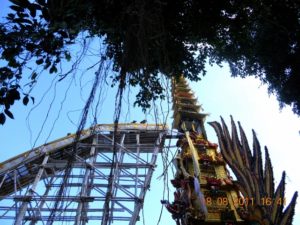
Launching the queen on her final voyage
There must have been a technical glitch because it took longer than you’d think to get the coffin onto the ski jump, then coast it down to the twenty-five-foot-high black-and-gold bull waiting on a canopied platform. When the men had it in place they tilted it to the side, decanted the queen into the bull, said a few words, closed the hatch on her, evacuated the platform, and set the whole thing on fire.

Decanting the queen into the bull
I don’t know what they used for fuel but from how quickly flames licked up around the ankles of the bull and how oily the smoke looked, I can’t help suspecting the presence of what arson investigators refer to as an accelerant.
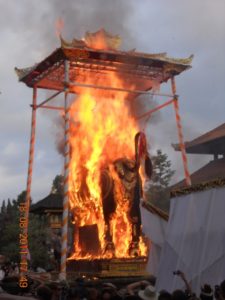
Months of handwork becoming purified
There’s a theology in there that involves purifying and returning the five elements of the universe that form the human body in our Micro-cosmos back to the macro-cosmos where the elements came from, or something like that. It makes as much sense as any other theology I know about.
Wherever the macro-cosmos might be and wherever those elements were supposed to be going, it wasn’t long before micro-cosmos parts of the queen were raining down on the bleachers and Peg and I began to realize why experienced funeral goers hadn’t clambered over the wall with us. Everybody in the bleachers, Hindu and atheist alike, declared their personal participation in the services to be at an end, and beat feet back toward town long before the queen’s earthly remains had been fully purified.


No Comments